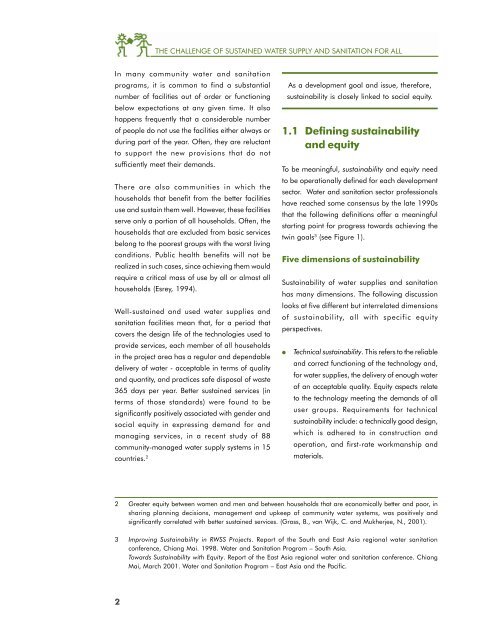Sustainability Planning and Monitoring
Sustainability Planning and Monitoring
Sustainability Planning and Monitoring
- No tags were found...
You also want an ePaper? Increase the reach of your titles
YUMPU automatically turns print PDFs into web optimized ePapers that Google loves.
THE CHALLENGE OF SUSTAINED WATER SUPPLY AND SANITATION FOR ALLIn many community water <strong>and</strong> sanitationprograms, it is common to find a substantialnumber of facilities out of order or functioningbelow expectations at any given time. It alsohappens frequently that a considerable numberof people do not use the facilities either always orduring part of the year. Often, they are reluctantto support the new provisions that do notsufficiently meet their dem<strong>and</strong>s.There are also communities in which thehouseholds that benefit from the better facilitiesuse <strong>and</strong> sustain them well. However, these facilitiesserve only a portion of all households. Often, thehouseholds that are excluded from basic servicesbelong to the poorest groups with the worst livingconditions. Public health benefits will not berealized in such cases, since achieving them wouldrequire a critical mass of use by all or almost allhouseholds (Esrey, 1994).Well-sustained <strong>and</strong> used water supplies <strong>and</strong>sanitation facilities mean that, for a period thatcovers the design life of the technologies used toprovide services, each member of all householdsin the project area has a regular <strong>and</strong> dependabledelivery of water - acceptable in terms of quality<strong>and</strong> quantity, <strong>and</strong> practices safe disposal of waste365 days per year. Better sustained services (interms of those st<strong>and</strong>ards) were found to besignificantly positively associated with gender <strong>and</strong>social equity in expressing dem<strong>and</strong> for <strong>and</strong>managing services, in a recent study of 88community-managed water supply systems in 15countries. 2As a development goal <strong>and</strong> issue, therefore,sustainability is closely linked to social equity.1.1 Defining sustainability<strong>and</strong> equityTo be meaningful, sustainability <strong>and</strong> equity needto be operationally defined for each developmentsector. Water <strong>and</strong> sanitation sector professionalshave reached some consensus by the late 1990sthat the following definitions offer a meaningfulstarting point for progress towards achieving thetwin goals 3 (see Figure 1).Five dimensions of sustainability<strong>Sustainability</strong> of water supplies <strong>and</strong> sanitationhas many dimensions. The following discussionlooks at five different but interrelated dimensionsof sustainability, all with specific equityperspectives.●Technical sustainability. This refers to the reliable<strong>and</strong> correct functioning of the technology <strong>and</strong>,for water supplies, the delivery of enough waterof an acceptable quality. Equity aspects relateto the technology meeting the dem<strong>and</strong>s of alluser groups. Requirements for technicalsustainability include: a technically good design,which is adhered to in construction <strong>and</strong>operation, <strong>and</strong> first-rate workmanship <strong>and</strong>materials.2 Greater equity between women <strong>and</strong> men <strong>and</strong> between households that are economically better <strong>and</strong> poor, insharing planning decisions, management <strong>and</strong> upkeep of community water systems, was positively <strong>and</strong>significantly correlated with better sustained services. (Gross, B., van Wijk, C. <strong>and</strong> Mukherjee, N., 2001).3 Improving <strong>Sustainability</strong> in RWSS Projects. Report of the South <strong>and</strong> East Asia regional water sanitationconference, Chiang Mai. 1998. Water <strong>and</strong> Sanitation Program – South Asia.Towards <strong>Sustainability</strong> with Equity. Report of the East Asia regional water <strong>and</strong> sanitation conference. ChiangMai, March 2001. Water <strong>and</strong> Sanitation Program – East Asia <strong>and</strong> the Pacific.2
















